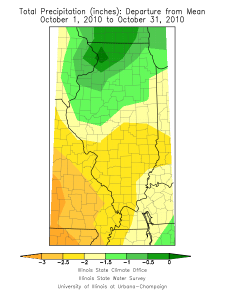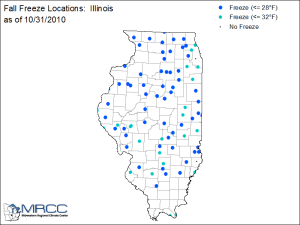Precipitation
For Illinois, the statewide average rainfall for October was 1.4 inches, 1.5 inches below normal or 48 percent of normal. This ranks as the 20th driest October on record. The largest monthly rainfall total was reported at Belvidere with 3.94 inches. See map below for rainfall departures across the state.
While northern Illinois was close to normal on rainfall in October, parts of southern and eastern Illinois remained dry. The U.S. Drought Monitor lists those areas as “abnormally dry” and southeastern Illinois as”moderate drought”. At this time of year, the main impacts on agriculture would be on pasture conditions and winter wheat.
Soil Moisture
With the vegetation preparing for a long winter’s nap and lower temperatures, the demands on soil moisture are close to zero. So soil moisture should start to recover in the next few months even if precipitation remains below normal. The Illinois State Water Survey posts their latest soil moisture survey a few days after the end of the month here.
Temperature
The statewide average temperature for October was 56.2 degrees, 1.6 degrees above normal. The highest temperature for the month was reported at Fairfield with 93 degrees on October 10. The lowest temperature for the month was reported at Minonk with 22 degrees on October 29 and Sidell with 22 degrees on October 30.
Frost
During October, nearly all of Illinois has experienced temperatures down to 32 degrees and many areas have reached 28 degrees or less. See map below.
Figures


All data are preliminary.




